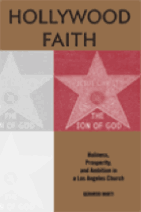Last week, I submitted the complete manuscript under contract with Oxford University Press!
[Insert fireworks and happy dance about here.]
Worship Across the Racial Divide examines how music and worship "work" in successfully diverse congregations.
Research for this book began in 2005 as I was completing my ethnography on Oasis, a black-white congregation ministering to workers in the Entertainment Industry and released as
Hollywood Faith (Rutgers University Press). With over a dozen churches, 170+ interviews, and reams of background information from scholars and practitioners, I am pleased with the result. Assuming all goes smoothly, I expect the book to be available in 2012.
This book goes into detail on what happens in the worship and music experience of diverse congregations. I decided to focus on this because worship and music are believed to provide "strategic" moments for churches to stimulate racial and ethnic diversity.
Inevitably, what may seem like a simple idea ("Let's bring in some multicultural music...") inevitably involves a complex of tricky notions of representation, ethnic difference, racial authenticity, and the always pragmatic considerations of church leaders who need to be ready for church services on a week to week basis.
When I began to explore the background, I quickly found that the research on race and music is huge. One of the reasons it took so long to write this book is sifting through a pile of reading. I had to constantly make decisions about what mattered most. All too often, even the most significant material had to be cut away in the final months as at around 140,000 words, the manuscript was much too long. The (intriguing) digressions were far too frequent, and the need to finish became very much a priority.
I would have liked to say much more about African American and Latino notions of "their music" and how this developed in the history of music and race in the United States. No space, no time!
I also found the literature on worship and race utterly fascinating. In reading documents from the mid-1800s, I saw how notions of African Americans as inherently religious (which is tied to their presumed "emotionality") continues to affect even the most informal discussion on racial worship. Black people worship differently -- so it is said. And the fact that church leaders and attenders BELIEVE blacks worship differently invokes the construction of sacred scenes which demand that blacks PERFORM worship differently. Some of this talk can sound like a lot of sociological mumbo-jumbo. But my observations and interviews reveal a fascinating dichotomy between blacks as they are expected to act when they are in the pews of diverse congregations and how they are expected to act when they are on the platform.
The interviews and stories from these congregations are striking. The book includes page after page of pastors, worship directors, and attenders talking about their experiences of worship, their views on diversity, and their connections of race and music in church. The ironies and unexpected insights continued to surprise me even in the final weeks of adding material and revising the manuscript.
The final draft of the book still weighs in at 100,000 words when you add footnotes and all. I think it is far too short. The amount of thinking left to do on worship, race, music, diversity, etc., is a rich arena of study. I'm glad I stumbled into it. So, whatever shortcomings may be in the book, it is so interesting and so important, I expect many others will pick up threads and make their own distinctive contribution.









